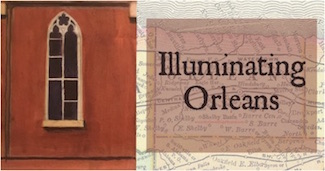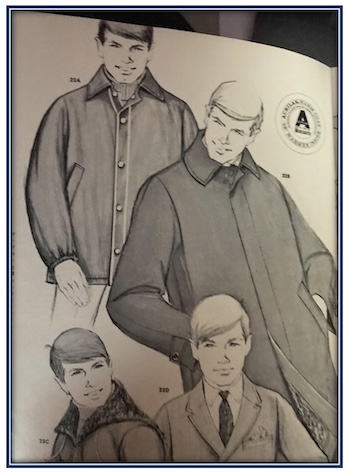Landauer’s Christmas catalog from 1967 promoted polyester clothing for partying, lounging

Loungewear, Landauer’s of Albion Christmas catalog, 1967
By Catherine Cooper, Orleans County Historian
“Illuminating Orleans” – Volume 4, Number 39

At first glance, the color scheme of this Landauer’s Christmas catalog appears jarring. But realizing that the catalog is from 1967 explains the teal, magenta and mustard colors. At the time, Landauer’s was the main department store in Albion.
This catalog lists items of clothing sold and worn just 63 years ago, still remembered (and owned?) by some, no doubt. But in terms of fashions, fabrics, colors and descriptions, this clothing might as well be from the crinoline era.
The clothing items shown above were listed as suitable “For Partying or Lounging” and, it is interesting to note that the colors are more seasonal than those shown on the cover.
The first item on the left, 2B, is a Lounger culotte of 80% Arnel® triacetate, 20% nylon. Three quarter sleeves. Styled by Lazy U. Washable. Colors: orange or lime $23.

Landauer’s Christmas catalog, 1967
Item 2C: Floral patterned quilt duster of Honan acetate crepe. Kodel® polyester fiberfill. Blue or gold. $16
Item 2D: A long robe version of Item 2C
Item 2E: Luxuriant “Radiant Fleece” duster of 80% Arnel Triacetate and 20% nylon with the look of velour. Front panel with embroidered grosgrain ribbon, concealed gripper closing. Colors: Tangerine, Kelly green, desert rose. $16
The colors are vibrant, the styles are non-restrictive, and the fabric is easy-care synthetic. Production of natural fabrics had declined during World War II due to the focus on the war effort. Synthetic fibers were developed in the 1950s to meet an increased demand for fabric. Tired of rationing and shortages, consumers were eager to buy new clothes. The new fabrics were popular as they were easy to wash, wrinkle-free, durable and affordable.
Of the fabrics listed in the above descriptions, Arnel® was a trademarked synthetic triacetate fabric developed in 1954 by the Celanese Corporation of America. It ceased production in 1984, due to increased toxicity standards for production and competition from newer polyesters.
Kodel® polyester was developed in 1958 by Eastman Chemical, a subsidiary of the Eastman Kodak Company. It felt like cotton but was more durable and less expensive to produce.
Ladies fashion also included Orlon® acrylic knits, “Fairfield She Shells”, cardigans and sweaters in vibrant colors – canary, lemonette, coquette pink, fresh grass and sprite green.

Men’s clothing, Launder’s of Albion catalog, 1967
With the heading “Handsome New Ideas for His World”, several pages feature coats and jackets for men and boys.
Item 22B: The fabulous Koratron® zip-out three season coat, lined with 100% Acrilon® acrylic tone tipped pile. Colors: black, navy, olive or British tan. $30.00
Koratron® was developed in 1956 by Joseph Koret who was working on creating a permanent crease product for men’s trousers. When coated with resin and baked at 325 degrees, the fabric permanently adopted creases as designed, while the remainder of the fabric remained wrinkle resistant.
The men’s dress shirts were made of Dacron® polyester and were “Sanforized®”, a pre-shrinking process developed by Sanford Cluett in 1930 that reduced shrinking after washing. Sport shirts were made from Ban-Lon® texturized nylon “that simply never needs ironing.”
Consumers in the 1960s embraced the convenience and versatility of clothing made from synthetic materials. The wash-and-wear, no-iron properties revolutionized laundry day. Sixty-three years later, we are more aware of the downside of the synthetic revolution and it’s detrimental effects on the environment.






























































